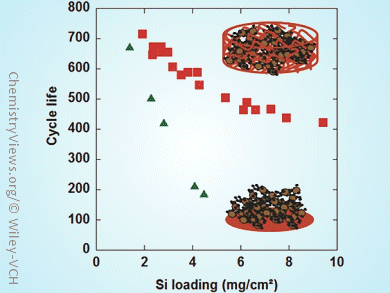Lithium-ion batteries (LIBs) are widely used for mobile devices because of their high energy density and low self-discharge rate, but this is still not sufficient for many demands. Si-based anodes are very attractive for LIBs owing to their very high gravimetric and volumetric capacity compared to graphite-based electrodes. However, when Si is electrochemically alloyed with Li to give Li15Si4 the increase in volume is as much as 270 %. This leads to destabilization of the solid electrolyte interface resulting in poor reversibility and rapid capacity degradation, thus excluding the use of Si electrodes in commercial LIBs so far.
Bernard Lestriez, Réseau sur le Stockage Electrochimique de l´Energie, Amiens, France, and colleagues evaluated Cu foam as a matrix to create 3D Si-based anodes. The electrodes are prepared by casting the slurry into the porosity of the Cu foam. Compared to the traditional 2D design the Cu foam reaches a good cyclability of 400 cycles at a loading of 10 mg/cm2 with a surface capactiy of 10 mAh/cm2. The thinness of the composite coating on the foam walls also favors a better preservation of the electronic wiring and fast Li-ion diffusion. Therefore, Cu foam is an appealing material for electrodes compared to traditional Cu foils.
- Very High Surface Capacity Observed Using Si Negative Electrodes Embedded in Copper Foam as 3D Current Collectors,
Driss Mazouzi, David Reyter, Magali Gauthier, Philippe Moreau, Dominique Guyomard, Lionel Roué, Bernard Lestriez,
Adv. Energy Mater. 2014.
DOI: 10.1002/aenm.201301718




